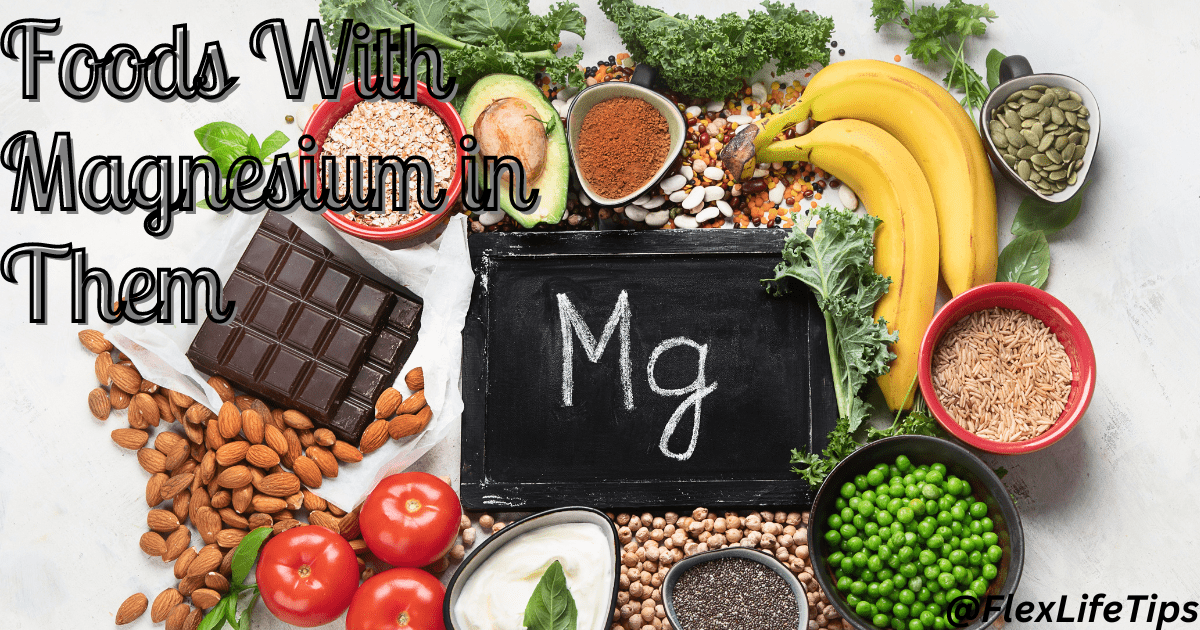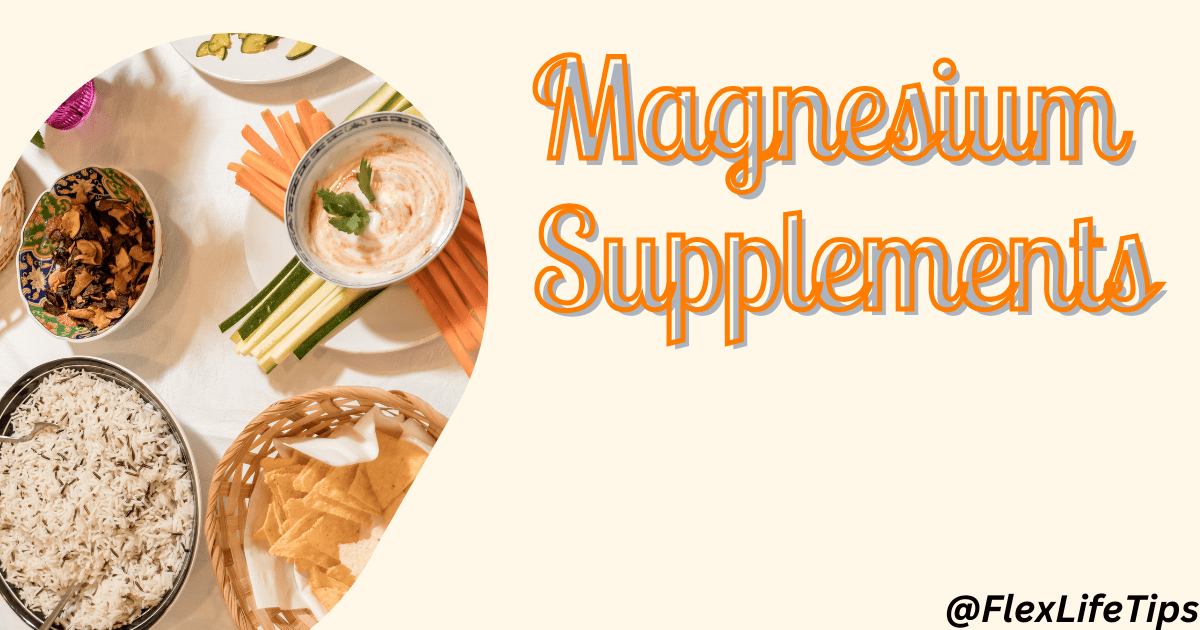Introduction of Foods With Magnesium in Them
Welcome to a journey of discovery into the realm of nutrition, specifically exploring the vital element, magnesium. In this concise guide, we will delve into the world of “foods with magnesium in them” an exploration of readily available and delicious sources that can contribute to your daily magnesium intake.
Magnesium plays a crucial role in maintaining our overall well-being, influencing various bodily functions. As we navigate through this article, we’ll uncover not only the diverse array of foods rich in magnesium but also the significance of this essential mineral for your health.
So, whether you’re seeking to enhance your dietary choices or are intrigued by the benefits of magnesium, join us in unraveling the secrets behind these foods that pack a powerful magnesium punch. Let’s embark on this insightful journey together, discovering the easy and enjoyable ways to incorporate magnesium into your daily meals.

Understanding Magnesium:
Magnesium, an essential mineral for the human body, is involved in numerous physiological processes that contribute to overall health. In this section, we’ll explore the fundamentals of magnesium, from its dietary recommendations to potential risks associated with its deficiency or excess.
What is magnesium?
Magnesium is a vital mineral that plays a key role in various bodily functions, including muscle and nerve function, blood glucose control, and bone health. It acts as a cofactor for numerous enzymes, facilitating biochemical reactions crucial for energy production and DNA synthesis.
Recommended Dietary Allowances for adults:
The Recommended Dietary Allowance (RDA) for magnesium varies by age and gender. For adult males, it ranges from 400 to 420 milligrams per day, while adult females require slightly less, ranging from 310 to 320 milligrams daily. These guidelines emphasize the importance of incorporating magnesium-rich foods into our diets.
How much magnesium is in your food?
Understanding the magnesium content in common foods is essential for maintaining a balanced diet. Incorporating foods with magnesium in them becomes crucial to meeting your daily requirements. The following section will delve into specific foods that serve as excellent sources of this essential mineral.
Can too much or too little magnesium be harmful?
While magnesium is crucial for health, an imbalance can lead to adverse effects. Inadequate magnesium intake may contribute to conditions like muscle cramps, fatigue, and abnormal heart rhythms. On the other hand, excessive magnesium intake, usually from supplements, can lead to diarrhea, nausea, and, in severe cases, toxicity.
Ensuring an appropriate balance is key, emphasizing the importance of obtaining magnesium through foods rather than relying solely on supplements.
As we transition into the next section, we will explore “Foods with Magnesium in Them,” providing a detailed guide to incorporating these nutritious elements into your daily meals.
Foods High in Magnesium:
In this section, we’ll uncover a variety of delicious options that fall under the category of “foods with magnesium in them.” These culinary delights not only add flavor to your meals but also contribute significantly to your daily magnesium intake.

Ten foods high in magnesium
- Whole Wheat:
- A staple in many diets, whole wheat products such as bread and pasta are not only rich in fiber but also a good source of magnesium. Swap refined grains for whole grains to boost your magnesium intake.
- Spinach:
- Packed with nutrients, spinach is a leafy green that offers a substantial dose of magnesium. Whether enjoyed fresh in salads or cooked in various dishes, spinach is a versatile addition to your diet.
- Quinoa:
- Known as a complete protein, quinoa is also a magnesium powerhouse. This ancient grain is an excellent alternative to traditional grains, providing a nutritional boost to your meals.
- Almonds, Cashews, and Peanuts:
- Nuts are not only a convenient and tasty snack but also rich in magnesium. Almonds, cashews, and peanuts can be easily incorporated into your diet as a standalone snack or as part of various dishes.
- Dark Chocolate:
- Indulge your sweet tooth with dark chocolate, which satisfies cravings and contains magnesium. Opt for dark chocolate with higher cocoa content for maximum nutritional benefits.
- Black Beans:
- A versatile legume, black beans are not only a great source of plant-based protein but also provide a significant amount of magnesium. Include them in soups, salads, or main dishes for a nutrient boost.
- Edamame:
- These young soybeans are not only delicious but also a good source of magnesium. Enjoy edamame as a snack, in salads, or as a side dish to increase your magnesium intake.
- Avocado:
- Beyond its creamy texture and rich flavor, avocado is a nutrient-dense fruit that includes magnesium. Whether sliced in a sandwich, added to salads, or mashed for guacamole, avocados are a tasty and nutritious addition to your diet.
- Tofu:
- As a versatile plant-based protein, tofu is also a good source of magnesium. Incorporate tofu into stir-fries, soups, or grilled dishes to increase your magnesium intake.
- Cultured Yoghurt:
- Yogurt, particularly the cultured variety, is not only a source of beneficial probiotics but also contains magnesium. Choose plain, unsweetened yogurt for a healthier option, and pair it with fruits or nuts for added flavor.
Fish for Magnesium
In addition to these plant-based sources, certain types of fish also contribute to your magnesium intake. Incorporating various magnesium-rich foods into your diet ensures a well-rounded approach to meeting your nutritional needs.
Vegetables and Fruits That Have Magnesium
Explore a spectrum of colorful vegetables and fruits that not only provide essential vitamins and minerals but also contribute to your daily magnesium requirements.
Whole-grain products With Magnesium
Discover the diverse range of whole-grain products that serve as a wholesome source of magnesium, enhancing both the nutritional value and taste of your meals.
Legumes, Nuts, and Seeds With Magnesium
Delve into the world of legumes, nuts, and seeds, uncovering a variety of options that not only add crunch and flavor to your dishes but also boost your magnesium intake.
Magnesium in Water
Beyond food sources, water can also be a contributor to your magnesium intake. Understanding the role of water in magnesium consumption adds another dimension to maintaining a balanced diet.
Magnesium-Fortified Foods
Explore the concept of fortified foods and how they can play a role in ensuring adequate magnesium intake, especially for individuals with specific dietary needs.
As we move forward, this detailed exploration of “Foods with Magnesium in Them” provides a comprehensive understanding of diverse options that cater to various tastes and preferences. Incorporating these foods into your daily meals is a simple and enjoyable way to enhance your magnesium intake and promote overall well-being.
Health Considerations:
In this section, we will delve into the health considerations associated with magnesium intake. From the benefits of incorporating foods with magnesium in them to understanding potential risks, this segment provides valuable insights for making informed dietary choices.

Magnesium Benefits
Magnesium offers a myriad of health benefits, influencing various physiological functions within the body. Ensuring an adequate intake of foods with magnesium in them can contribute to:
- Muscle Function: Magnesium is essential for proper muscle function, including contraction and relaxation. Adequate magnesium intake may help reduce muscle cramps and promote overall muscle health.
- Nervous System Support: The mineral plays a crucial role in the functioning of the nervous system, contributing to neurotransmitter regulation and nerve signal transmission.
- Bone Health: Magnesium is a key component in maintaining bone density and structure. It works in tandem with calcium to support overall bone health.
- Heart Health: Adequate magnesium intake is associated with a lower risk of cardiovascular issues. It helps regulate blood pressure and supports heart rhythm stability.
- Energy Production: Magnesium is involved in the production of adenosine triphosphate (ATP), the body’s primary energy currency. Sufficient magnesium levels can contribute to optimal energy production.
- Blood Sugar Regulation: Magnesium plays a role in insulin function and glucose metabolism, contributing to the regulation of blood sugar levels.
Amounts and Dosage
While the benefits of magnesium are evident, it’s essential to strike a balance in your intake. The Recommended Dietary Allowance (RDA) provides guidelines for daily magnesium intake, emphasizing the importance of obtaining the mineral from foods rather than relying solely on supplements.
Top Picks
As you explore “foods with magnesium in them,” here are some top picks to consider incorporating into your daily meals:
- Spinach: Rich in magnesium and versatile for various dishes.
- Almonds: A convenient and tasty snack packed with magnesium.
- Salmon: A fish option providing both omega-3 fatty acids and magnesium.
- Bananas: A potassium-rich fruit that also contains magnesium.
- Quinoa: A nutrient-dense grain alternative with magnesium.
Magnesium Risks
While magnesium deficiency is a concern, it’s equally important to be aware of potential risks associated with excessive magnesium intake. These risks are often associated with overconsumption of magnesium supplements rather than obtaining the mineral through foods.
- Gastrointestinal Issues: High doses of magnesium supplements can lead to diarrhea and other gastrointestinal issues.
- Kidney Issues: Individuals with kidney problems may be at risk of magnesium toxicity if their kidneys cannot excrete excess magnesium efficiently.
- Drug Interactions: Excessive magnesium intake can interfere with certain medications, leading to adverse effects.
To mitigate these risks, it’s advisable to focus on obtaining magnesium from a varied and balanced diet, incorporating a range of foods with magnesium in them.
As we transition to the next section, keep in mind the health benefits and considerations associated with magnesium intake. By making informed choices and enjoying a diverse array of magnesium-rich foods, you can contribute to your overall well-being.
Additional Information:
This section provides additional insights into “foods with magnesium in them.” From being cautious of certain compounds to considering the option of magnesium supplements, we explore aspects beyond the nutritional content of these foods.
Be Wary of Phytic Acids
While incorporating foods with magnesium in them, it’s essential to be mindful of certain compounds that can affect mineral absorption. Phytic acids, naturally present in some grains, legumes, and seeds, can bind to minerals like magnesium, hindering their absorption. To maximize magnesium absorption, consider diversifying your diet and exploring preparation methods that may reduce phytic acid content, such as soaking or fermenting.
Should I take magnesium supplements?
While obtaining magnesium from foods is generally preferable, some individuals may consider supplements under specific circumstances. However, it’s crucial to approach supplementation cautiously:

- Consult with a Healthcare Professional: Before adding magnesium supplements to your routine, consult with a healthcare professional. They can assess your individual needs and provide personalized recommendations.
- Consider Dietary Sources First: Whenever possible, prioritize obtaining magnesium from foods. Supplements should complement, not replace, a balanced diet.
- Choose High-Quality Supplements: If supplementation is recommended, opt for high-quality magnesium supplements. Different forms of magnesium have varying absorption rates, so selecting an appropriate form is important.
- Avoid Excessive Dosages: Stick to recommended dosages, as excessive magnesium intake from supplements can lead to adverse effects.
This additional information serves as a guide to optimizing magnesium intake while considering factors that may impact absorption and the potential role of supplements in specific scenarios.
External Resources:
In this section, we’ll explore external resources that complement our understanding of “foods with magnesium in them.” These sources provide additional context, expert insights, and diverse perspectives on magnesium-rich diets and their impact on overall health.
Healthdirect – Free Australian Health Advice
Healthdirect is a reliable source offering free health advice, including valuable information on dietary choices. Explore their resources for insights into maintaining a balanced diet, understanding nutritional needs, and incorporating “foods with magnesium in them” into your meals.
Health Conditions Related to Nutrition | myVMC
MyVMC provides comprehensive information on health conditions related to nutrition, shedding light on how dietary choices, including magnesium intake, can impact overall well-being. Dive into their articles to expand your knowledge on the intersection of nutrition and health.
Better Health Channel – Vitamins and Minerals
The Better Health Channel offers a dedicated section on vitamins and minerals, including detailed information on magnesium. Gain a deeper understanding of how magnesium contributes to health, and discover additional “foods with magnesium in them” to diversify your diet.
Nutrition Australia – Nuts in a Healthy Diet
Explore Nutrition Australia’s insights into the role of nuts in a healthy diet, emphasizing their nutritional benefits, including magnesium content. Discover creative ways to incorporate nuts into your meals, enhancing both flavor and nutritional value.
Eat For Health – Vegetables and Legumes/Beans
The Eat For Health initiative provides evidence-based information on the benefits of vegetables and legumes/beans. Delve into their resources to explore the magnesium content of various plant-based foods and learn how to maximize their nutritional impact.
Crohn’s Disease and Ulcerative Colitis – Better Health Channel
For individuals managing digestive conditions like Crohn’s disease and ulcerative colitis, the Better Health Channel offers insights into dietary considerations. Explore how “foods with magnesium in them” can be part of a supportive diet for those with specific health challenges.
Pathology Tests Explained – Magnesium
For a detailed look at magnesium from a medical perspective, Pathology Tests Explained provides insights into magnesium testing and its significance. Understand how healthcare professionals assess magnesium levels and how dietary choices play a role.
Ausmed – What is Hypokalaemia?
Explore Ausmed’s resources to understand the relationship between magnesium and potassium levels in the body. Gain insights into conditions like hypokalaemia and how a balanced diet, including “foods with magnesium in them,” can contribute to overall electrolyte balance.
External resources provide a wealth of information to complement your journey into the world of “foods with magnesium in them.” By tapping into these expert perspectives and diverse insights, you can further enhance your understanding of the role magnesium plays in promoting health and well-being.
As you navigate these external resources, remember to critically assess the information and tailor it to your individual needs. By combining external knowledge with the practical tips and insights shared in this guide, you’re well-equipped to make informed choices for a magnesium-rich and nutritious lifestyle.
FAQs
Here are frequently asked questions (FAQs) about “foods with magnesium in them“:
- Q: Why is magnesium important for our health?
- A: Magnesium is crucial for various bodily functions, including muscle and nerve function, bone health, and energy production. Consuming foods with magnesium in them supports overall well-being.
- Q: What are the top foods with magnesium?
- A: Foods with magnesium in them include whole wheat, spinach, quinoa, almonds, cashews, peanuts, dark chocolate, black beans, edamame, avocado, tofu, and cultured yogurt.
- Q: How can I incorporate more foods with magnesium in my diet?
- A: Easily integrate magnesium-rich foods by incorporating whole grains, leafy greens, nuts, seeds, and legumes into your meals. Experiment with diverse recipes to make the process enjoyable.
- Q: Are there specific fruits high in magnesium?
- A: While fruits generally contain less magnesium compared to other food groups, bananas, and avocados are examples of fruits with magnesium in them. Including a variety of fruits in your diet complements your overall nutritional intake.
- Q: Can I get enough magnesium from supplements alone?
- A: While supplements can be beneficial in certain situations, it’s generally recommended to obtain magnesium from a balanced diet with foods with magnesium in them. Whole foods provide a spectrum of nutrients beyond magnesium.
- Q: Are there any risks associated with consuming too much magnesium from foods?
- A: Obtaining magnesium from foods poses minimal risks, as the body typically excretes excess magnesium. However, excessive magnesium intake from supplements can lead to adverse effects, so it’s essential to prioritize dietary sources.
- Q: What role does magnesium play in heart health?
- A: Magnesium contributes to heart health by regulating blood pressure and supporting heart rhythm stability. Consuming foods with magnesium in them is linked to a lower risk of cardiovascular issues.
- Q: How does magnesium benefit muscle function?
- A: Magnesium is essential for proper muscle function, including muscle contraction and relaxation. Consuming foods with magnesium in them helps reduce the risk of muscle cramps and supports overall muscle health.
- Q: Can I obtain enough magnesium without including nuts and seeds in my diet?
- A: While nuts and seeds are excellent sources of magnesium, there are alternative sources such as whole grains, leafy greens, and legumes. Diversifying your diet with various foods with magnesium in them ensures a well-rounded intake.
- Q: Are there specific foods with magnesium suitable for vegetarians and vegans?
- A: Absolutely! Vegetarians and vegans can include magnesium-rich foods like whole grains, leafy greens, tofu, and legumes in their diet. These plant-based options provide ample magnesium for those following a plant-centric lifestyle.
Remember, incorporating a variety of foods with magnesium in them into your diet not only supports your nutritional needs but also adds diversity and flavor to your meals.
Conclusion:
In the realm of nutrition, the significance of embracing “foods with magnesium in them” cannot be overstated. This exploration into the world of magnesium-rich options unveils not only the essential mineral’s vital role in our well-being but also the diverse and flavorful choices available to us.
By prioritizing a diet rich in whole grains, leafy greens, nuts, seeds, and legumes, we lay the foundation for optimal health. The versatility of these foods with magnesium in them allows us to craft meals that are not only nutritious but also delicious, fostering a sustainable and enjoyable approach to wellness.
As we conclude our journey through this guide, remember that the benefits extend beyond mere nutrition. The incorporation of foods with magnesium in them is a celebration of variety, taste, and the vibrant palette of nature’s offerings.